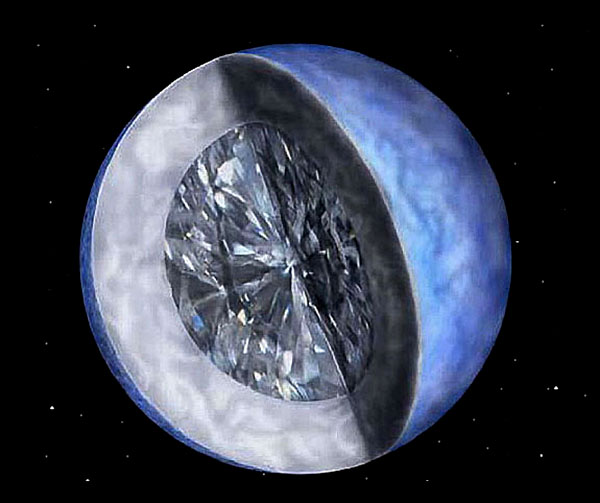August 30th, 2022
With all the recent internet buzz over asteroids strewn with precious metals and exoplanets where it rains liquid rubies and sapphires, we found this a perfect time to unpack a story we originally published in the summer of 2014 about a dwarf star made completely of diamonds.

Fifty light-years away in the constellation Centaurus is a white dwarf star two-thirds the size of the Earth that's likely the galaxy’s largest diamond weighing in at 10 billion trillion trillion carats.
Given the pet name “Lucy” by astronomers in deference to the Beatles’ famous song, “Lucy In The Sky With Diamonds,” the dwarf star is officially known as “BPM 37093.” It is 4,000km in diameter, and likely the coldest white dwarf ever detected.
“You would need a jeweler’s loupe the size of the Sun to grade this diamond,” joked astronomer Travis Metcalfe, who led the team that studied it at the Harvard-Smithsonian Center for Astrophysics.
Today, Metcalfe runs the Golden, CO-based White Dwarf Research Corporation, a non-profit organization dedicated to scientific research and public education. He also heads up a non-profit adopt-a-star program to help fund research.
The white dwarf star is the compressed dying remnant of what used to be a star very much like our Sun. Once a star uses up its fuel, it shrinks in on itself and starts to cool off. Since it’s made mostly of carbon, the crystallization of the super-dense material produces a diamond.
Before you think about planning a mining expedition to Lucy, take note that her super-cool temperature (compared to other stars) is still a blistering 5,000 degrees F, nearly twice the melting point of steel. Our sun at its core is about 27 million degrees F.
White dwarf stars are nearly impossible to identify because they are extremely difficult to see. Lucy, for instance, shines with only 1/2000th of the Sun’s visual brightness. Lacking visual clues, astronomers have relied on other methods to pinpoint a white dwarf in space. In the case of Lucy, she happens to do an “orbital tango” with a pulsar, or fast-spinning neutron star.
Metcalf noted that in five billion years our own Sun would likely meet the same fate as Lucy. It will cool down, shrink, crystallize and become a huge diamond in the center of our solar system.
“Our sun will become a diamond that truly is forever,” said Metcalfe.
Credit: Image by Harvard-Smithsonian Center for Astrophysics / Travis Metcalfe, Ruth Bazinet.

Fifty light-years away in the constellation Centaurus is a white dwarf star two-thirds the size of the Earth that's likely the galaxy’s largest diamond weighing in at 10 billion trillion trillion carats.
Given the pet name “Lucy” by astronomers in deference to the Beatles’ famous song, “Lucy In The Sky With Diamonds,” the dwarf star is officially known as “BPM 37093.” It is 4,000km in diameter, and likely the coldest white dwarf ever detected.
“You would need a jeweler’s loupe the size of the Sun to grade this diamond,” joked astronomer Travis Metcalfe, who led the team that studied it at the Harvard-Smithsonian Center for Astrophysics.
Today, Metcalfe runs the Golden, CO-based White Dwarf Research Corporation, a non-profit organization dedicated to scientific research and public education. He also heads up a non-profit adopt-a-star program to help fund research.
The white dwarf star is the compressed dying remnant of what used to be a star very much like our Sun. Once a star uses up its fuel, it shrinks in on itself and starts to cool off. Since it’s made mostly of carbon, the crystallization of the super-dense material produces a diamond.
Before you think about planning a mining expedition to Lucy, take note that her super-cool temperature (compared to other stars) is still a blistering 5,000 degrees F, nearly twice the melting point of steel. Our sun at its core is about 27 million degrees F.
White dwarf stars are nearly impossible to identify because they are extremely difficult to see. Lucy, for instance, shines with only 1/2000th of the Sun’s visual brightness. Lacking visual clues, astronomers have relied on other methods to pinpoint a white dwarf in space. In the case of Lucy, she happens to do an “orbital tango” with a pulsar, or fast-spinning neutron star.
Metcalf noted that in five billion years our own Sun would likely meet the same fate as Lucy. It will cool down, shrink, crystallize and become a huge diamond in the center of our solar system.
“Our sun will become a diamond that truly is forever,” said Metcalfe.
Credit: Image by Harvard-Smithsonian Center for Astrophysics / Travis Metcalfe, Ruth Bazinet.


